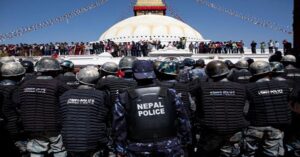 More than 9,000 Tibetan refugees living in Nepal, along with 600 from other nations, are to be left with no valid ID. Nepal is looking at issuing refugee identification cards to the Bhutanese refugees living in the country only, according to a recent Home Ministry of Nepal proposal to the Cabinet.
More than 9,000 Tibetan refugees living in Nepal, along with 600 from other nations, are to be left with no valid ID. Nepal is looking at issuing refugee identification cards to the Bhutanese refugees living in the country only, according to a recent Home Ministry of Nepal proposal to the Cabinet.
“There has been no decision made yet”, Shanker Koirala, a senior government official of the Home Ministry, replied, when asked if Tibetan refugees are also on track to be handed refugee ID cards (RCs).
These refugee identification cards are essential for a self-sustainable existence as they grant the holders the right to pursue higher education, do business, get employed and access basic services like opening a bank account or applying for a driver’s license, all of which is prohibited to refugees staying in Nepal without valid ID.
In total, there are more than 12,.500 Tibetan refugees living in Nepal, of these, more than 75% do not own a valid refugee identification card, according to the United Nations refugee office.The government of Nepal stopped documenting and issuing RCs to Tibetan refugees in 1990. It does not recognise Tibetans who arrived in the country after 1990, nor the children of people who arrived before 1990 as refugees.
Nepal granted refugees coming from Tibet a safe transit passage through Nepal to India for many years following China’s invasion of Tibet, this was in line with a Gentleman’s Agreement with the United Nations High Commissioner for Refugees (UNHCR), the organisation responsible for the transfer of incoming refugees to Dharamsala in North India. However, this is no longer the case and in recent times several military intelligence-sharing agreements between China and Nepal have been signed, with the goal to improve border security, especially along traditional refugee routes. These have severely restricted this route out of Tibet.
Human Rights Watch (HRW), the international independent human rights advocacy organisation, reported in 2014“The available evidence suggests that Tibetans detained by Chinese authorities for crossing the border irregularly from Nepal are routinely imprisoned and physically abused in China”. HRW’s report said that Nepalese border security forces are forcibly sending refugees back into Tibet and on occasion handing over to the Chinese authorities Tibetan refugees who have already reached Nepal. Actions that are illegal under international law.
The numbers of refugees from Tibet arriving in Nepal has dropped from an annual average of 2.200 before 2008 to only 53 in 2017, according to UNHCR statistics.
Nepal’s Ministry of Foreign Affairs website states, “Nepal is firmly committed to [the]One-China policy and is also committed not to allow its soil to be used for any inimical activities against China”. China gives Nepal financial aid, which comes with the cost of demanding Nepal’s loyalty to its policies.
For Tibetans staying in Nepal, even holders of valid RCs, this means restrictions when celebrating religious festivals, permanent surveillance, no right to openly show the Tibetan flag, demonstrate or speak out on topics opposing China, including the Tibetan independence movement, as Narendra Bastola, head of the Human Rights Organisation of Nepal (HURON) points out.
HRW has called for Nepal to immediately issue refugee identification cards to Tibetan refugees, as they provide a “modicum of protection, including “the right to reside in Nepal.” The United States government and multiple other western states, together with various human rights organisations, support this approach.
Tibetan refugees living in Nepal fear for their safety without a refugee ID card. “I thought I would be safe here. But now I realise China is telling Nepal what to do about us”, says Tibetan refugee Dorjee Tsering.
The uncertain situation is causing confusion and concern not only about refugee identification cards but also identity itself, especially in young Tibetans who grew up in Nepal.
“I know I am a Tibetan, but part of me is a Nepalese too,” says Tenzin, representing the issue of many children of refugees, “I was born here [in Nepal] and my home is here. But there is no future for us here.”
Sundeep Pathak, head of the HURON sums it up: “Their lack of an RC or any form of documentation means they are totally stateless and have absolutely no place in this world.”
“At the end of the day, who are we, and what is our identity?”,asks one anonymous refugee. “What is our history? Is it the one given in our fake document, or is it the one we are born with?”




 Print
Print Email
Email